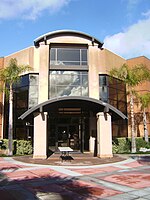San Dimas High School
1970 establishments in CaliforniaEducational institutions established in 1970Public high schools in Los Angeles County, CaliforniaSan Dimas, CaliforniaVague or ambiguous time from June 2021 ... and 2 more
Valle Vista LeagueWikipedia indefinitely semi-protected biographies of living people
San Dimas High School is a secondary school located in San Dimas, California, in the United States. It is part of the Bonita Unified School District. Most of the students come from Lone Hill Middle School which shares the same city block as the High School. The school has a student body of 1,296 and an API score of 839. The mascot is the Saint and was originally depicted as a knight slaying a dragon. The school is also referred to by students as SD. Its colors are royal blue and bright gold.
Excerpt from the Wikipedia article San Dimas High School (License: CC BY-SA 3.0, Authors).San Dimas High School
West Covina Boulevard,
Geographical coordinates (GPS) Address Nearby Places Show on map
Geographical coordinates (GPS)
| Latitude | Longitude |
|---|---|
| N 34.099 ° | E -117.823 ° |
Address
West Covina Boulevard
West Covina Boulevard
91773
California, United States
Open on Google Maps




